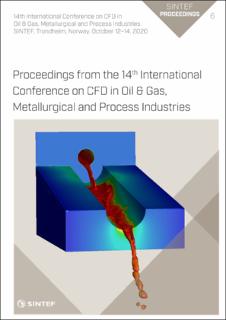| dc.contributor.author | PANJWANI, Balram | |
| dc.contributor.author | PETTERSEN, Torbjørn | |
| dc.contributor.author | WITTGENS, Bernd | |
| dc.date.accessioned | 2020-12-22T20:41:22Z | |
| dc.date.available | 2020-12-22T20:41:22Z | |
| dc.date.issued | 2020 | |
| dc.identifier.isbn | 978-82-536-1684-1 | |
| dc.identifier.issn | 2387-4295 | |
| dc.identifier.uri | https://hdl.handle.net/11250/2720852 | |
| dc.description.abstract | Flue gas Recycling (FGR) is a well-known method for NOx reduction. A feasibility study is presented on the potential use of FGR in ferro-silicon production. The aim of the study is to illustrate how recycling of flue gas into the furnace for temperature control will affect local temperatures and NOx formation in the furnace hood (the flue gas combustion zone) of a conventional furnace design. Computational fluid dynamic (CFD) simulations using a generic model of a submerged arc furnace (SAF) developed in previously NFR financed projects like ProMiljø are performed. The SAF model consists of seven charging pipes, three electrodes and one flue gas stack. ANSYS FLUENT was used for modelling the interaction between process gas, ambient air, and flue gas. The simulation results show that introduction of recirculated flue gas affects the peak temperatures since the reduced oxygen concentration of flue gas significantly reduce the reaction rates compared to injection of air. A corresponding effect on NOx formation has been demonstrated, results indicate an order of magnitude reduction in NOx formation when recirculated flue gas ( 6vol% O2) is used in the combustion zone instead of air (21vol% O2). Simulations of the rapid increase in NOx production during an avalanche within the furnace is simulated using theoretical flow profiles. The effects of 1) recirculated flue gas, 2) rapid increase in the process gases from charging bed (burst), and 3) effect of radiation on NOx have been studied. The study showed that FGR has significant effect on NOx reduction. The study also showed that accounting for radiation is very relevant for an accurate estimation of NOx. The formation of process gas burst through a charging surface increase the rate of NOx formation. | en_US |
| dc.language.iso | eng | en_US |
| dc.publisher | SINTEF Academic Press | en_US |
| dc.relation.ispartof | 14th International Conference on CFD in 6 Oil & Gas, Metallurgical and Process Industries SINTEF, Trondheim, Norway, October 12–14, 2020 | |
| dc.relation.ispartofseries | SINTEF Proceedings;6 | |
| dc.rights | CC BY | * |
| dc.rights.uri | https://creativecommons.org/licenses/by/4.0/ | * |
| dc.subject | CFD | en_US |
| dc.subject | Ox | en_US |
| dc.subject | Radiation | en_US |
| dc.subject | Combustion | en_US |
| dc.subject | Flue gas recycling - FGR | en_US |
| dc.title | CONTROLLING FLUE GAS TEMPERATURE FROM FERRO SILICON SUBMERGED ARC FURNACES (SAF) USING FLUE GAS RECIRCULATION (FGR) | en_US |
| dc.type | Chapter | en_US |
| dc.type | Peer reviewed | en_US |
| dc.description.version | publishedVersion | en_US |
| dc.rights.holder | © 2020 The Authors. Published by SINTEF Academic Press. | en_US |
| dc.identifier.cristin | 1862931 | |

